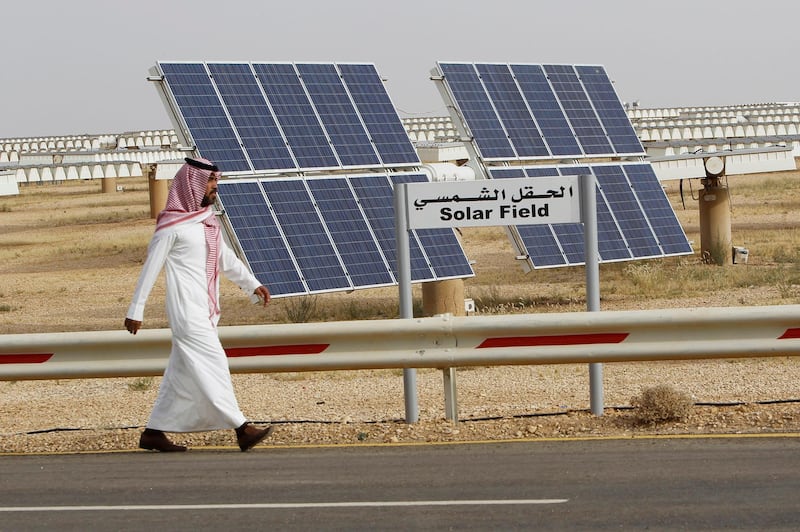Saudi Arabia, the world’s biggest oil exporter, is expected to lead renewable energy developments this year with up to $7 billion worth of new tenders, according to an official from the International Renewable Energy Agency.
“Saudi Arabia has huge potential because it has a big market and has very ambitious renewable energy targets,” said Rabia Ferroukhi, head of policy unit at the Abu Dhabi-based agency “The regulatory environment is well established now to conduct auctions and attract investors.”
Saudi Arabia is expected to tender over 4 Gigawatts of renewable projects this year, which could be worth anywhere between $5bn to $7bn, she added.
Saudi Arabia, which largely burns oil to generate power, has set ambitious targets to add 9.5GW of renewables by 2023, as it looks to sell more of its crude to export markets. The Saudi energy ministry’s renewables office is expected to tender 3.25GW of solar and 800 Megawatts of wind capacity this year alone.
Saudi Arabia is set to break ground on its first ever solar plant later this year, a $302 million, 300MW solar photovoltaic facility that will be developed by Riyadh-based Acwa Power on the basis of an independent power producer model.
Saudi Arabia’s inaugural 400MW wind project received four bids in April with the kingdom likely to award the scheme later this month.
But Saudi Arabia’s biggest project is a $200bn, 200GW solar development, set to be the world’s largest. Japan’s Softbank and Saudi Arabia’s Public Investment Fund are leading the development, which will be completed by 2030, create 100,000 jobs and reduce the cost of generating electricity.
“The talks between PIF and Softbank become quite important because it shows there is a clear interest from one of the largest investment funds in the world to be involved in renewables in Saudi Arabia,” said Ms Ferroukhi. “But other institutions will be needed, foreign banks, to be involved in the project.”
______
Read more:
China's Silk Road Fund is investing in Dubai solar project, Acwa says
Middle East renewables sector to register 24% CAGR by 2025, says GE
Saudi Arabia's first wind project receives four bids
______
Saudi Arabia is also expected to include elements of localisation in future projects, including Softbank’s development, where winners of contracts use local services and products in the ventures they are undertaking, according to analysts.
“The localisation requirements for this [Softbank project], if imposed as envisaged, would result in Saudi Arabia gaining the critical mass required to become one of the largest export bases for many components/ products in the solar value chain,” said Abhay Bhargava, director and business head of the Middle East and Africa Industrial Practice at consultancy Frost & Sullivan.
“It would also result in an unprecedented transfer of technology to Saudi Arabia, for not just the products and components, but also for skills and information technology - spurred by the need to integrate such a large base of renewables into the existing grids. Storage solutions would be a critical requirement for solar at this scale - we can expect many grid scale solutions to be tried in the Saudi Arabia for the first time ever in the region.”
For example, the $302m solar project included a 30 per cent local content requirement and the involvement of local banks. The 30 per cent target is expected to be increase further in future tenders.
“Saudi Arabia is in a good place in terms of creating a domestic industry and probably in the long run even exporting at least to the region if not further,” said Ms Ferroukhi.
Saudi Arabia is benefitting from record low prices for solar and wind.
According to Irena, costs for solar PV could drop by a further 60 per cent, offshore wind by 35 per cent and Concentrated Solar Power by 45 per cent over the next decade. CSP comes with storage, which allows the solar power to be fed into a grid even when the sun is not shining. But this also means that CSP is more expensive than PV, which has a quicker installation time because it has fewer moving parts.
Analysts are also bullish on Saudi Arabia’s renewables ambitions and lower prices, given their recent trajectory.
“It is only a question of time when prices for solar PV will drop below 1 cents,” said Cornelius Matthes, senior vice-president of Dii Desert Energy. “Both solar and wind in countries with good yield are now significantly lower than conventional electricity generation. Who would still invest in fossils from now on? Existing conventional assets will have hard time to compete in the daily load curve.”






